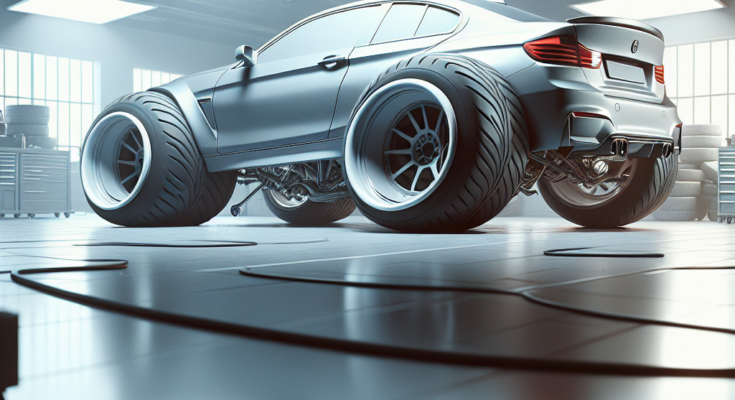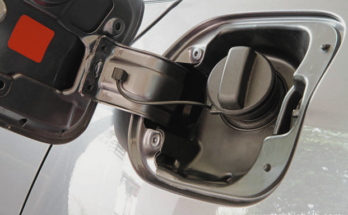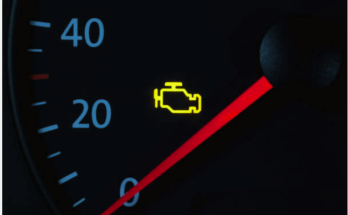Key Highlights
- Uneven tire wear is a common cause of bad camber angle, which can lead to premature wear on the outer or inner edges of the tires.
- Bad camber angle can affect the stability of a vehicle, causing it to pull to one side and making it harder to control.
- It also affects the overall tire life, as excessive camber can lead to uneven tire wear and reduce the lifespan of the tires.
- Proper camber settings and regular wheel alignment are essential to prevent bad camber angles and ensure optimal tire performance.
- A professional mechanic can diagnose and adjust the camber angle of a vehicle using specialized tools and equipment.
Introduction
When it comes to vehicle performance and handling, one crucial factor often overlooked is the camber angle. Camber refers to the tilt of the wheels relative to the vertical axis when viewed from the front or rear of the car. It can be categorized into positive and negative camber angles, each of which has a significant impact on your car’s stability, tire wear, and overall driving experience.
Understanding and maintaining the correct camber angle is crucial for optimal vehicle performance and safety. In this article, we’ll delve into the details of how positive and negative camber angles affect your car’s performance and handling. We’ll also discuss the common symptoms of bad camber angle and the potential risks associated with it. Whether you’re a daily driver or a performance enthusiast, understanding camber angles can help you make informed decisions about your vehicle’s maintenance and setup.
Understanding Camber Angle in Cars
Camber angle is the measure of how much a car’s wheel leans either towards or away from the vehicle’s centerline. When the top of the wheel tilts outward, it’s called a positive camber, while when it tilts inward, it’s referred to as a negative camber. The camber angle is measured in degrees.
Camber angle plays a crucial role in the vehicle’s suspension system. It affects the contact patch between the tire and the road surface, which directly impacts handling and tire wear. The ideal camber angle for a specific vehicle depends on factors such as the vehicle’s design, intended use, and driving conditions.
In addition to positive and negative camber, there is also a concept of neutral camber, where the top of the wheel is perfectly vertical. This is the ideal camber angle for most passenger vehicles, as it provides a balance between tire wear and handling performance.
The camber angle is influenced by various suspension components, including control arms, ball joints, and struts. These components help to maintain the desired camber angle and ensure proper tire contact with the road surface. Regular inspection and maintenance of these suspension components are essential to maintain the correct camber angle and prevent any potential issues.
The role of Camber Angle in Vehicle dynamics
Camber angle plays a crucial role in a vehicle’s performance and handling characteristics. It directly affects the tire contact patch, which is the area of the tire that is in contact with the road surface.
When a car has the correct camber angle, the tire’s contact patch is maximized, providing optimal grip and traction. This improves the vehicle’s cornering ability and overall handling performance. On the other hand, an incorrect camber angle can reduce the contact patch, resulting in reduced grip and handling.
Additionally, camber angle influences the vehicle’s body roll, which is the degree of lateral lean during cornering. A car with excessive positive camber may exhibit more body roll, compromising stability and cornering ability. Conversely, negative camber can help reduce body roll, enhancing stability and cornering performance.
Overall, the camber angle is a crucial factor in determining a vehicle’s performance and handling characteristics. Proper camber alignment ensures optimal tire contact with the road surface, leading to improved vehicle dynamics.
Types of Camber: Positive, Negative, and Zero
There are three types of camber angles: positive camber, negative camber, and zero camber. Each type has its own distinct characteristics and is suited for different purposes.
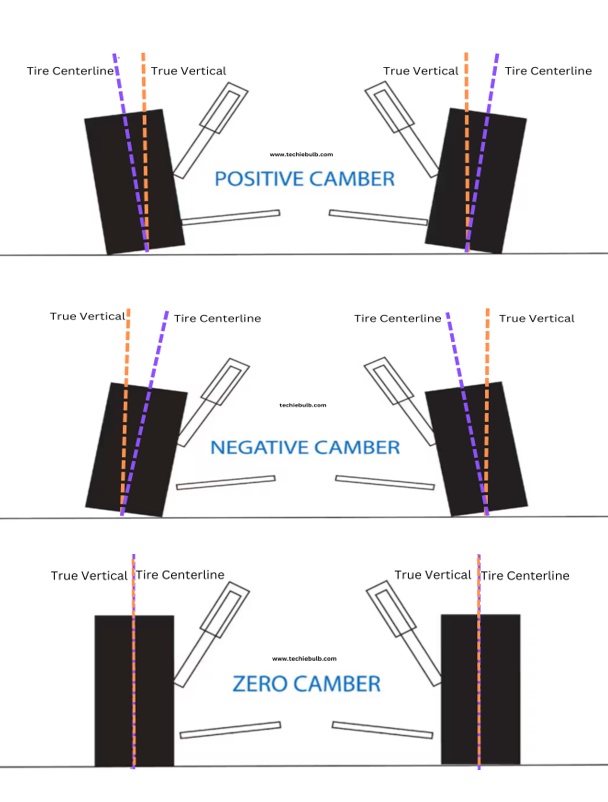
- Positive Camber: This occurs when the top of the wheel tilts outward. Positive camber angles are rarely seen on modern passenger vehicles because they can have adverse effects on handling. However, they are sometimes intentionally set on utility vehicles like off-road trucks and farm equipment to enhance stability during heavy-load carrying or off-road applications.
- Negative Camber: This occurs when the top of the wheel tilts inward. Negative camber angles are more common in modern vehicles, especially performance and sports cars. They offer improved cornering stability and grip, making the vehicle feel more responsive and agile during turns. Negative camber angles are often preferred in motorsports for their performance benefits.
- Zero Camber: This occurs when the top of the wheel is perfectly perpendicular to the ground. Zero camber is rarely seen in practical applications and is not commonly used because it does not provide any significant benefits for performance driving.
Different types of camber angles are used to achieve specific performance goals in different driving scenarios. It’s important to understand the purpose and effects of each type to determine the most suitable camber angle for your vehicle.
Identifying Bad Camber Angle: Common Symptoms
Identifying a bad camber angle is crucial for maintaining your car’s performance and safety. There are several common symptoms that can indicate a problem with the camber angle:
- Uneven Tire Wear: One of the most noticeable signs of a bad camber angle is uneven tire wear. Excessive wear on the inner or outer edges of the tires is a clear indication that the camber angle is not properly adjusted.
- Vehicle Pulling to One Side: If your car tends to pull to one side while driving, it could be a sign of an improper camber angle. This can affect the vehicle’s stability and make it more difficult to maintain a straight line.
- Handling and Cornering Issues: A bad camber angle can also result in handling issues, such as poor cornering performance, reduced traction, and a less responsive steering feel. If you notice any of these symptoms, it’s important to have your camber angle checked and adjusted if necessary.
If you experience any of these symptoms, it’s recommended to have your camber angle checked by a professional mechanic to ensure optimal performance and safety.
Uneven Tire Wear Patterns
One common sign of a wrong camber angle is uneven tire wear, which can make tires wear out faster and become unsafe. When the camber angle isn’t right, tires might wear excessively on the inner or outer edges.
- Inner Edge Wear: Too much negative camber causes extra wear on the inner edge, shortening tire life and risking safety.
- Outer Edge Wear: Too much positive camber leads to extra wear on the outer edge, also reducing tire life and safety.
Regularly check your tire tread for uneven wear. If you see any unusual patterns, get your camber settings checked and fixed by a professional mechanic.
Vehicle Pulling to One Side
Another symptom of a bad camber angle is when your vehicle tends to pull to one side while driving. This can be caused by an improper camber angle that affects the vehicle’s alignment settings and suspension geometry.
When the camber angle is not properly adjusted, it can result in an uneven distribution of weight on the tires. This can cause the vehicle to pull towards the side with the more significant camber angle.
Additionally, a damaged or worn control arm can also contribute to the vehicle pulling to one side. The control arm is responsible for controlling the movement of the wheels and can affect the camber angle if it is not functioning correctly.
If you experience vehicle pulling to one side, it’s essential to have your alignment settings and suspension components checked by a professional mechanic. They can identify and address any issues with the camber angle or control arm that may be causing the problem.
Handling and Cornering Issues
A bad camber angle can significantly impact a car’s handling and cornering performance. The incorrect camber angle can result in several issues that affect the overall driving experience.
Excessive positive or negative camber can lead to increased body roll during cornering. Body roll refers to the lateral movement of a car’s body when turning, and it can negatively affect the vehicle’s stability and handling.
Improper camber angles can also reduce the tire’s contact patch with the road surface, leading to reduced traction and compromised cornering performance. This can result in a less responsive steering feel and reduced overall vehicle stability.
For performance driving enthusiasts, optimal camber angles are crucial for achieving the desired grip and stability during aggressive cornering. Adjusting the camber angles to suit specific driving styles or performance goals can improve cornering performance and enhance the overall driving experience.
It’s important to address any handling or cornering issues by having the camber angles checked and adjusted by a professional mechanic.
How Bad Camber Angle Affects Your Car
A bad camber angle can have several negative effects on your car’s performance, safety, and overall driving experience. Here are a few ways in which a bad camber angle can impact your car:
- Tire Life: Excessive positive or negative camber can lead to uneven tire wear, reducing the lifespan of your tires. This not only increases your maintenance costs but also compromises safety.
- Fuel Efficiency: Improper camber angles can increase rolling resistance and drag, leading to reduced fuel efficiency. This can result in higher fuel consumption and increased expenses.
- Safety Concerns: A bad camber angle can affect your car’s stability, handling, and traction, potentially compromising safety on the road. It’s crucial to address any camber issues to ensure safe driving conditions.
By maintaining proper camber angles, you can improve tire life, fuel efficiency, and overall safety of your vehicle.
Impact on Tire Lifespan and Performance
One of the significant impacts of a bad camber angle is on the lifespan and performance of your tires. Improper camber angles can result in premature tire wear and reduced overall tire performance.
When the camber angle is not properly adjusted, it can lead to uneven tire wear. Excessive wear on the inner or outer edges of the tire compromises its lifespan and safety. Additionally, improper camber angles can also affect the tire’s contact patch, which is the area of the tire that is in contact with the road surface. This can result in reduced grip and traction, negatively impacting the tire’s performance.
By maintaining optimal camber angles through regular alignment checks and adjustments, you can extend the lifespan of your tires and ensure optimal tire performance.
Effects on Fuel Efficiency
A bad camber angle can also have an impact on your vehicle’s fuel efficiency. Improper camber angles can increase rolling resistance and drag, leading to reduced fuel efficiency.
When the camber angle is not correctly adjusted, it can affect the alignment settings of the vehicle. Misaligned wheels can cause uneven tire wear and increased rolling resistance, resulting in higher fuel consumption. Additionally, improper camber angles can also affect the tire’s contact patch, reducing the tire’s efficiency in transferring power.
Furthermore, tire pressure plays a crucial role in fuel efficiency. Improper camber angles can contribute to uneven tire wear, which can lead to variations in tire pressure. Inconsistent tire pressure can further impact fuel efficiency.
To ensure optimal fuel efficiency, it’s important to maintain proper camber angles through regular alignment checks and adjustments, as well as proper tire pressure.
Safety Concerns Related to Poor Camber Adjustment
A bad camber adjustment can pose safety concerns for a vehicle. Incorrect camber angles can negatively impact a car’s stability and handling, compromising safety on the road.
Excessive positive or negative camber can affect a car’s stability during turns. Too much positive camber can make the vehicle less stable, especially during sharp turns, and may result in excessive body roll. On the other hand, too much negative camber can reduce stability and traction, potentially leading to unpredictable handling.
Addressing camber issues requires the expertise of a professional mechanic who can accurately adjust the camber angles to ensure optimal stability and handling. Attempting to adjust camber angles without proper knowledge and equipment can lead to further safety concerns.
To maintain safe driving conditions, it’s essential to have your camber angles adjusted by a qualified mechanic who can ensure proper alignment and optimize vehicle stability and safety.
Diagnosing Camber Issues: Tips and Tricks
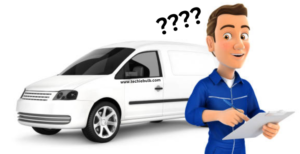
Diagnosing camber issues in your car requires a combination of visual inspection and the use of specialized tools. Here are some tips and tricks to help you identify potential camber issues:
- Visual Inspection of Tires: Start by visually inspecting your tires for any signs of uneven wear. Look for excessive wear on the inner or outer edges of the tires, which may indicate a camber problem. Additionally, check for any bulges or cuts on the tire sidewalls, as these can also affect camber alignment.
- Using a Camber Gauge for Accurate Measurements: To accurately measure the camber angle, you can use a camber gauge. This tool allows you to measure the angle of the wheel in relation to the vertical axis. Follow the manufacturer’s instructions to attach the camber gauge to the wheel and obtain accurate measurements.
- Consider Tire Size: It’s important to consider the tire size when diagnosing camber issues. Different tire sizes can affect the camber angle and may require adjustments to ensure proper alignment.
If you suspect any camber issues, it’s best to consult with a professional mechanic who has the expertise and specialized tools to accurately diagnose and address the problem.
Visual Inspection of Tires
One of the primary methods for diagnosing camber issues is through a visual inspection of the tires. By closely examining the tires, you can identify potential signs of camber misalignment.
Start by looking for any signs of uneven tire wear. Excessive wear on the inner or outer edges of the tires is a clear indication of camber misalignment. Additionally, check the tread depth across the tire. Uneven tread wear can also be a sign of camber issues.
During the visual inspection, it’s also important to consider the tire size. Different tire sizes can affect the camber angle and may require adjustments to ensure proper alignment.
If you notice any irregularities or signs of camber misalignment during the visual inspection, it’s recommended to have your camber angles checked and adjusted by a professional mechanic.
Using a Camber Gauge for Accurate Measurements
To accurately measure the camber angle of your car’s wheels, a camber gauge can be used. This tool provides precise measurements and helps in determining the degree of camber misalignment.
Using a camber gauge involves attaching the tool to the wheel and measuring the angle of the wheel in relation to the vertical axis. The gauge will provide the measurement in degrees, indicating the amount of camber misalignment.
While a camber gauge can be purchased and used by car enthusiasts, it’s recommended to consult with a professional mechanic for accurate measurements and adjustments. A professional mechanic has the expertise and experience to interpret the measurements and make the necessary adjustments to achieve the desired camber angle.
For accurate camber measurements and adjustments, it’s best to rely on the services of a qualified professional mechanic who can ensure proper alignment and optimal performance.
Fixing Bad Camber Angle: Solutions and Recommendations
Fixing a bad camber angle requires adjusting the alignment of the wheels. This process, known as wheel alignment, should be performed by a professional mechanic who has the expertise and specialized equipment to accurately adjust the camber angles.
For daily drivers, it’s recommended to consult with a professional mechanic for camber angle adjustments. They can ensure the camber angles are properly aligned for optimal performance and safety on the road.
Attempting to adjust camber angles without proper knowledge and equipment can lead to further issues and safety concerns. Therefore, it’s best to leave camber angle adjustments to a professional mechanic who can provide accurate and reliable services.
When to Consider Professional Wheel Alignment
Professional wheel alignment is necessary when dealing with camber issues and ensuring optimal performance. Here are some situations when you should consider professional wheel alignment:
- Camber Issues: If you suspect camber misalignment or experience symptoms like uneven tire wear, vehicle pulling, or handling issues, it’s essential to have your camber angles checked and adjusted by a professional mechanic.
- Suspension Repairs: After any suspension repairs or component replacements, it’s recommended to have a professional wheel alignment to ensure proper camber angles and overall alignment.
- Regular Maintenance: As part of regular vehicle maintenance, it’s wise to have a professional wheel alignment at least once a year. This helps to ensure proper camber angles and overall alignment, enhancing the lifespan and performance of your tires.
By consulting with a professional mechanic for wheel alignment, you can address camber issues and maintain optimal performance and safety on the road.
Adjusting Camber at Home: Is It Feasible?
Adjusting camber at home can be challenging and is not recommended for most car owners. It requires specialized tools and expertise to accurately measure and adjust the camber angles.
While some car enthusiasts may attempt to adjust camber angles themselves, it’s important to consider the complexity of the task. Adjusting camber angles involves working with suspension components, such as control arms, which require knowledge and experience to handle properly.
Improper camber adjustments can lead to further issues, affecting the vehicle’s stability, handling, and safety. Therefore, it’s best to leave camber angle adjustments to a professional mechanic who has the necessary expertise and equipment to ensure accurate and reliable results.
For optimal performance and safety, it’s recommended to consult with a professional mechanic for camber angle adjustments.
Preventative Measures to Maintain Optimal Camber Angle
To maintain optimal camber angles and ensure proper alignment, there are several preventative measures you can take:
- Regular Alignment Checks: Schedule regular wheel alignment checks with a professional mechanic. This helps to identify any camber misalignment issues early on and correct them before they lead to more significant problems.
- Monitoring Tire Wear: Regularly inspect your tire tread for any signs of uneven wear. Uneven wear patterns can indicate camber issues, and addressing them promptly can prevent further damage to your tires.
- Maintaining Proper Tire Pressure: Proper tire pressure is crucial for achieving optimal performance and reducing unnecessary wear. Regularly check and maintain the recommended tire pressure to ensure even tire wear and proper contact with the road surface.
By taking these preventative measures, you can maintain optimal camber angles, extend the lifespan of your tires, and ensure safe and reliable performance from your vehicle.
Regular Alignment Checks
Regular alignment checks are essential for maintaining optimal camber angles and overall wheel alignment. Here’s why regular alignment checks are crucial:
- Ensure Proper Alignment: Regular alignment checks help to ensure that your car’s wheels are properly aligned, including the camber angles. This helps to maintain optimal performance and safety.
- Correct Camber Misalignment: If any camber misalignment is detected during the alignment check, a professional mechanic can adjust the camber angles to bring them back to the factory settings or align them to your specific requirements.
- Extend Tire Lifespan: Properly aligned wheels, including the camber angles, promote even tire wear. This extends the lifespan of your tires and reduces the need for premature replacements.
- Professional Expertise: Alignment checks should be performed by a professional mechanic who has the expertise and specialized equipment to accurately measure and adjust the camber angles.
By scheduling regular alignment checks with a professional mechanic, you can maintain optimal camber angles, enhance tire lifespan, and ensure safe and reliable performance from your vehicle.
Monitoring Tire Wear and Pressure
Monitoring tire wear and maintaining proper tire pressure are important aspects of maintaining optimal camber angles and overall tire performance. Here’s why it’s crucial:
- Tire Tread Wear: Regularly inspecting your tire tread for any signs of uneven wear can help identify camber misalignment issues. Uneven wear patterns can indicate the need for camber angle adjustments.
- Tire Lifespan: Proper camber angles and regular alignment checks help promote even tire wear, extending the lifespan of your tires. This reduces the need for premature tire replacements and saves you money in the long run.
- Tire Pressure: Maintaining proper tire pressure is essential for optimal tire performance and even wear. Inconsistent tire pressure can affect camber angles and lead to uneven tire wear.
By monitoring tire wear and maintaining proper tire pressure, you can identify camber issues early on, extend tire lifespan, and ensure safe and reliable performance from your tires.
Conclusion
In conclusion, understanding and maintaining the camber angle of your car is crucial for optimal vehicle performance and safety. From identifying common symptoms of bad camber angles to diagnosing and fixing issues, proactive care can extend tire lifespan, enhance fuel efficiency, and ensure better handling. Regular alignment checks and monitoring tire wear are key preventative measures to preserve the camber angle. Whether considering professional wheel alignment or adjusting at home, prioritizing camber angle maintenance will lead to a smoother driving experience and prolonged vehicle health. Stay informed, stay aligned!

